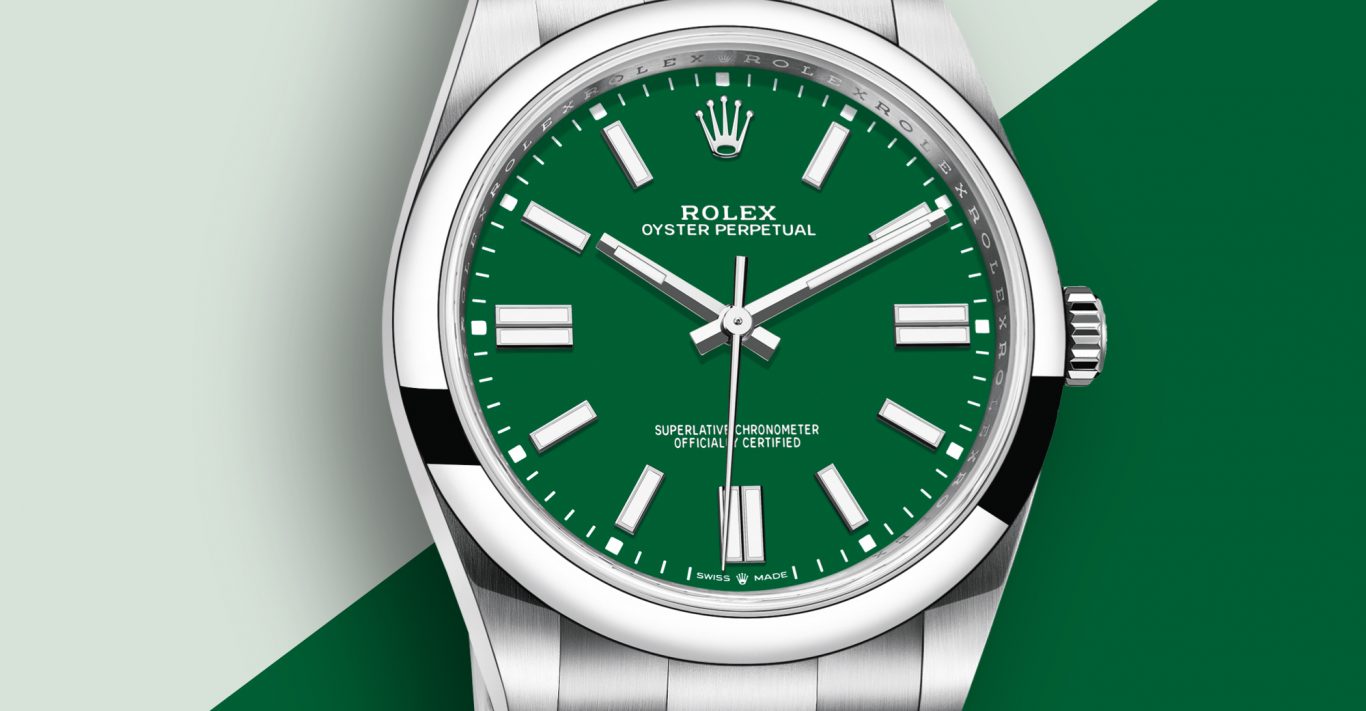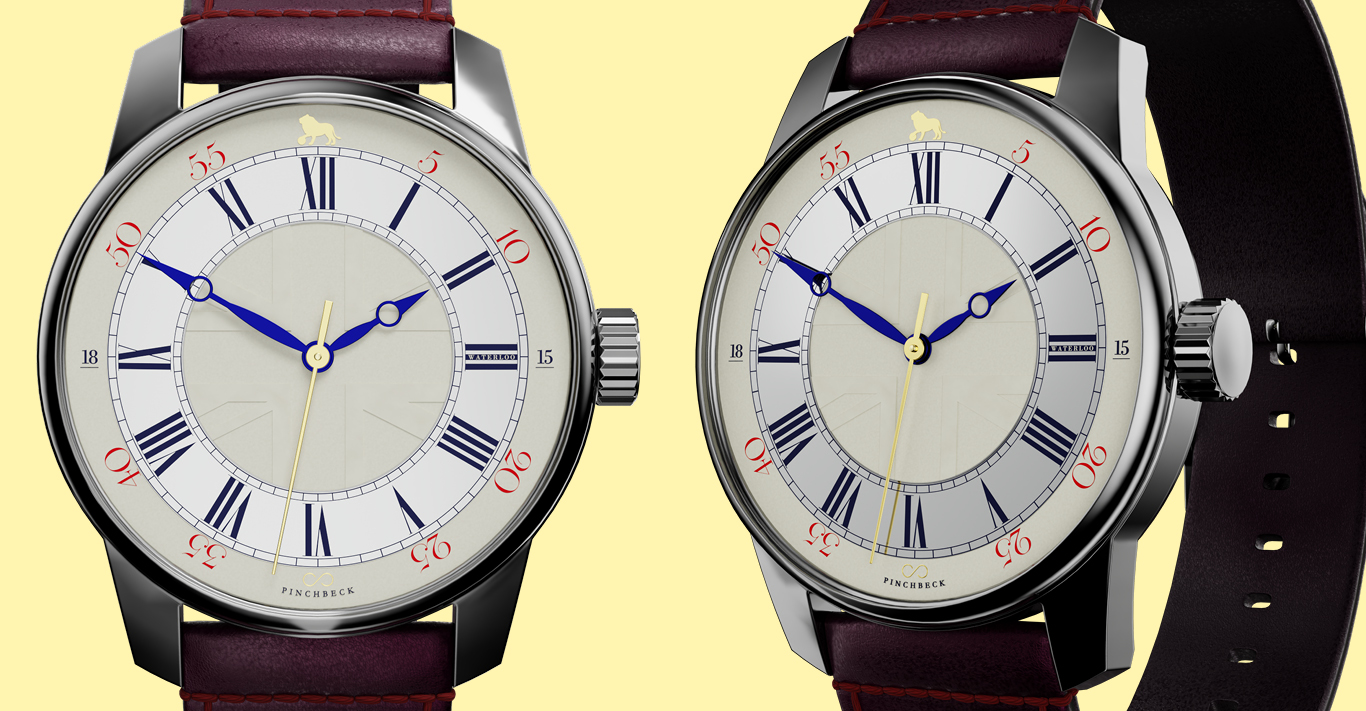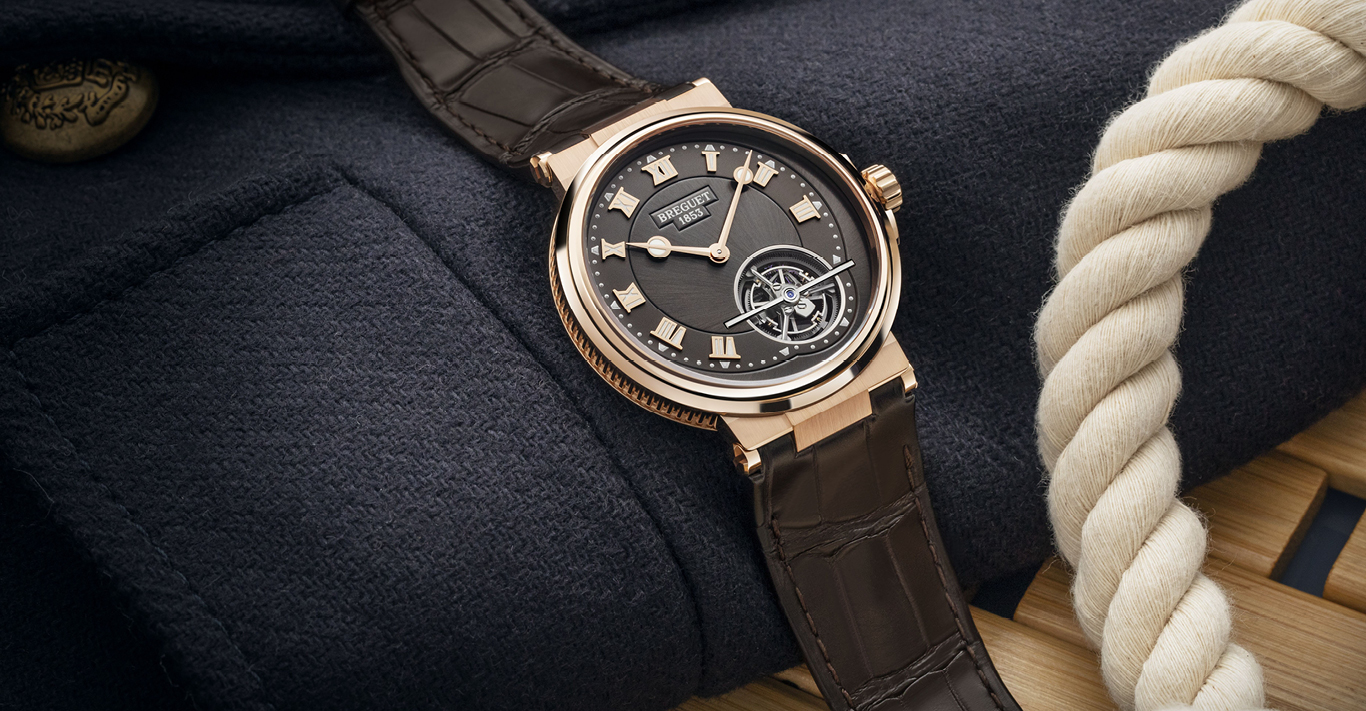WORDS
Richard Holt
As senior members of staff at David M Robinson, VIP sales manager Sandy Madhvani, showroom manager Bale Sekulceska and assistant showroom manager Jonathan Tyers have between them many years’ expertise and knowledge of Rolex timepieces. Here they select some of their favourites from the current collections and describe what they admire about each piece.
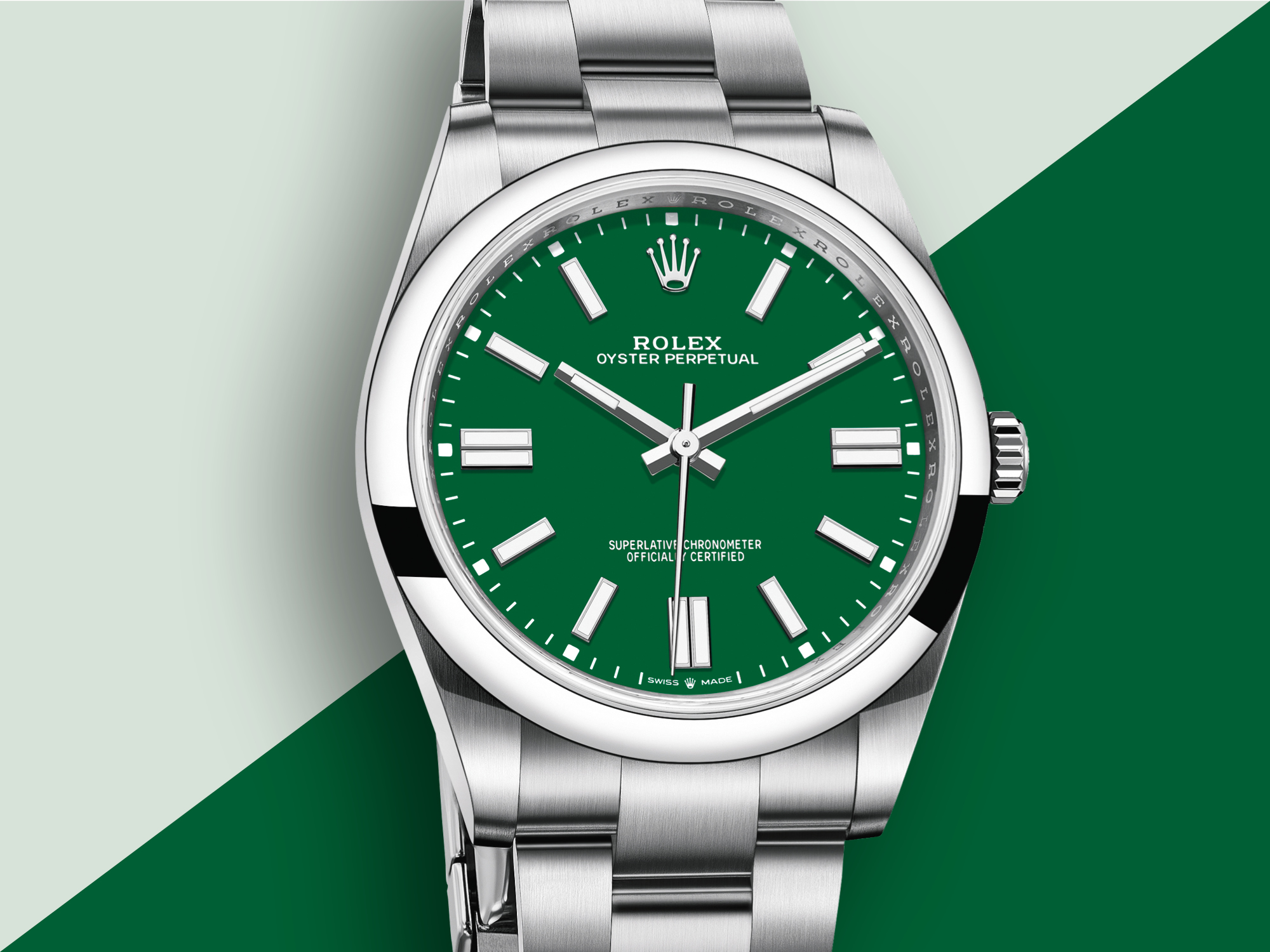
Oyster Perpetual
Jonathan says: ‘Rolex really stunned us last year when they brought out the Oyster Perpetual in a range of bold colours. They really have been a stand-out for the brand – amazingly fun watches that have helped open up Rolex to a whole new generation of buyers. The 41mm with the green dial is the one for me.’
The classic Oyster Perpetual is the most accessible model in the range and last year was given a big shake-up with the introduction of a bigger 41mm case size with the Oyster Perpetual 41 and the introduction of a range of bright, popping colours. Rolex has played around with colour before, but never at this end of the range. The new-generation Oyster Perpetual comes with a Chromalight display – hands and hour markers are filled with luminous material, giving a long-lasting blue glow in low-light conditions.
The 41mm and the new versions of the 36mm are fitted with Rolex’s newly developed calibre 3230 self-winding movement. Smaller models in the range, which now start at 28mm, carry the 2232 movement, another newly developed Rolex calibre. Like all Rolex models, all of the watches within the Oyster Perpetual range carry Rolex’s demanding Superlative Chronometer certification, ensuring exceptional performance of +/- 2 seconds per day and, as ever, backed up with Rolex’s international five-year guarantee. The 2232 has a power reserve of approximately 55 hours, while the 3230 has a reserve of approximately 70 hours. The Oyster bracelet, introduced back in the late 1930s, has broad, flat three-piece links and is the most widely used bracelet in the Oyster collection. All models are guaranteed waterproof to 100 metres.
Oyster Perpetual 41, £4,700

Datejust 36
Sandy says: ‘The Datejust watch is an absolute classic. It has been around since 1945 and the watch is still recognisable today. The addition of new details like the stunning olive-green palm dial gives a new depth of appeal to one of Rolex’s most iconic designs and looks like an instant hit.’
Rolex has introduced four new versions of its Oyster Perpetual Datejust 36 with visually alluring new dials. The palm motif can be seen on three of the new watches. The first watch has an olive green dial matched with an Oystersteel case on an Oyster bracelet (pictured). The second has the golden palm motif dial but matched with yellow Rolesor – the bezel, winding crown and centre links of the bracelet are in 18ct yellow gold, the case and outer links of the bracelet are in Oystersteel. The third watch has a silver dial paired with Everose Rolesor, combining Oystersteel and 18ct Everose gold on a Jubilee bracelet. The final version has a fluted bezel and a golden dial combined with yellow Rolesor and a Jubilee bracelet. The new versions of the Datejust 36 are fitted with calibre 3235, a self-winding movement featuring Rolex’s patented Chronergy escapement and offering a power reserve of approximately 70 hours. The Oyster and Jubilee bracelets on the Datejust 36 are equipped with a folding Oysterclasp and include Rolex’s Easylink comfort extension link, allowing the wearer to easily adjust the bracelet length by approximately 5 mm. The 36mm Oyster case is guaranteed waterproof to a depth of 100 metres.
Datejust 36 from £5,650
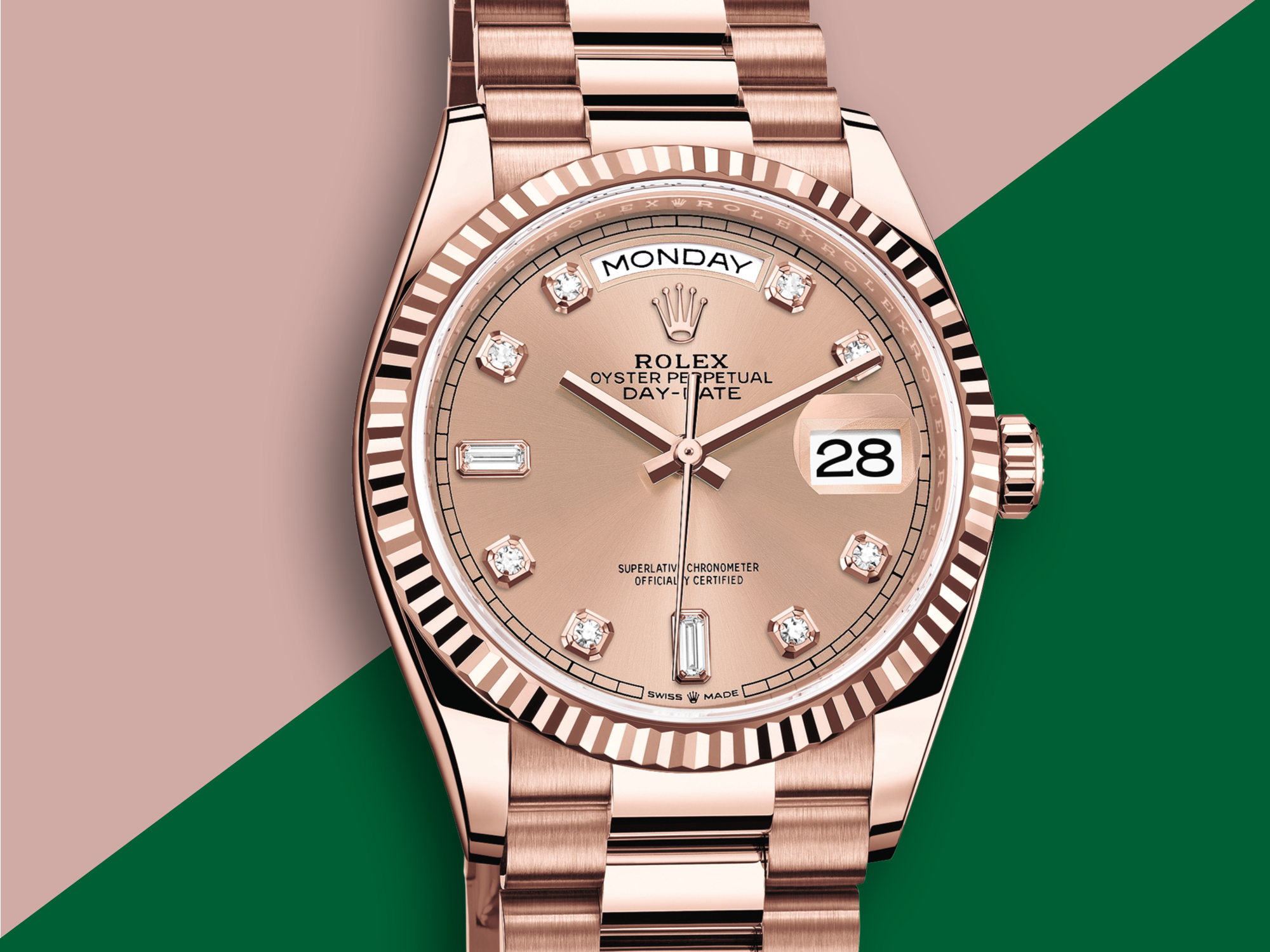
Day-Date
Sandy says: ‘In all my 30-plus years of working with Rolex this watch has always stood out as the absolute best of the best for me. Officially called the Oyster Perpetual Day-Date, most people simply call it the President. And it’s a great name, not just because it has been worn by so many US presidents, but because it really is the boss. A stunning watch that looks great whatever you are wearing.’
Launched in 1956, the Oyster Perpetual Day-Date was worn by Lyndon B Johnson and one was given to John F Kennedy by Marilyn Monroe, and is routinely called the President by everyone but Rolex. Officially only the bracelet is called President. Made exclusively in either gold or platinum and featuring three semi-circular links, the President bracelet was made specially for the Day-Date at its launch and has become a Rolex classic in itself. The bracelet now benefits from modern upgrades in the form of ceramic inserts in the links to increase flexibility. The Day-Date is fitted with calibre 3255 – a new-generation movement that features the efficient Chronergy escapement, Parachrom hairspring and a 70-hour power reserve. The Day-Date was the first calendar wristwatch to show the day of the week in full as well as the date. While it has since benefited from many technical upgrades, this function remains the key feature of these watches, with the day and date at 12 and 3 o’clock respectively, updating instantly as the time hits midnight. It comes in a case size of either 36mm or 40mm, available exclusively in 18ct gold (yellow, Everose or white) or 950 platinum.
Day-Date from £26,650
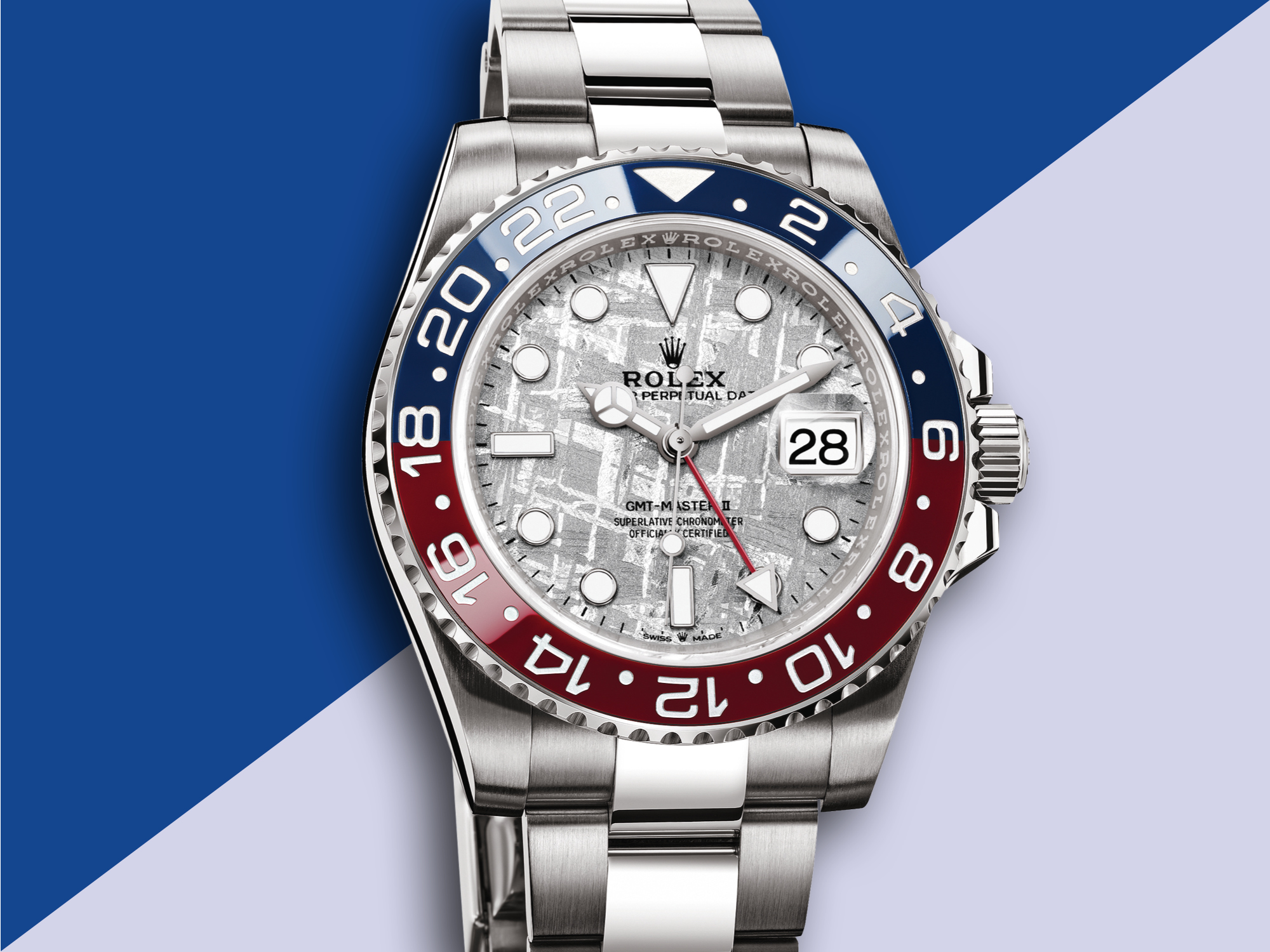
GMT-Master II
Bale says: ‘Launched in 1955 as the GMTMaster, the modern evolution of the watch celebrates the rapid expansion of air travel in the second half of the 20th century and for me, it really captures the glamour of those early years of intercontinental air travel. It has recently been offered with a number of very appealing updates – the white-gold model with the meteorite dial is absolutely stunning.’
In function as well as in name, the GMT-Master II evokes long-distance travel across time zones. Greenwich Mean Time (GMT) marks time at the Royal Observatory in Greenwich, London – historically the location of the official prime meridian used for calculating longitude and determining different time zones around the world. Back in the 1950s when flying between continents was a glamorous part of the new post-war world, the GMT-Master became the official watch of Pan Am, and was worn by their stylishly dressed pilots. In 1982, Rolex introduced a new movement that allowed the hour hand to be set independently of the other hands. To mark this evolution, the watch was renamed the GMT-Master II. In addition to conventional hour, minute and seconds hands displaying the local time, the GMT-Master II has an arrow-tipped hand that circles the dial once every 24 hours and a bidirectional rotating bezel and a 24-hour Cerachrom insert in two-tone ceramic. When abroad, travellers can set the local time easily, with the hour hand “jumping” from hour to hour thanks to a mechanism operated via the winding crown.
GMT-Master II from £7,750
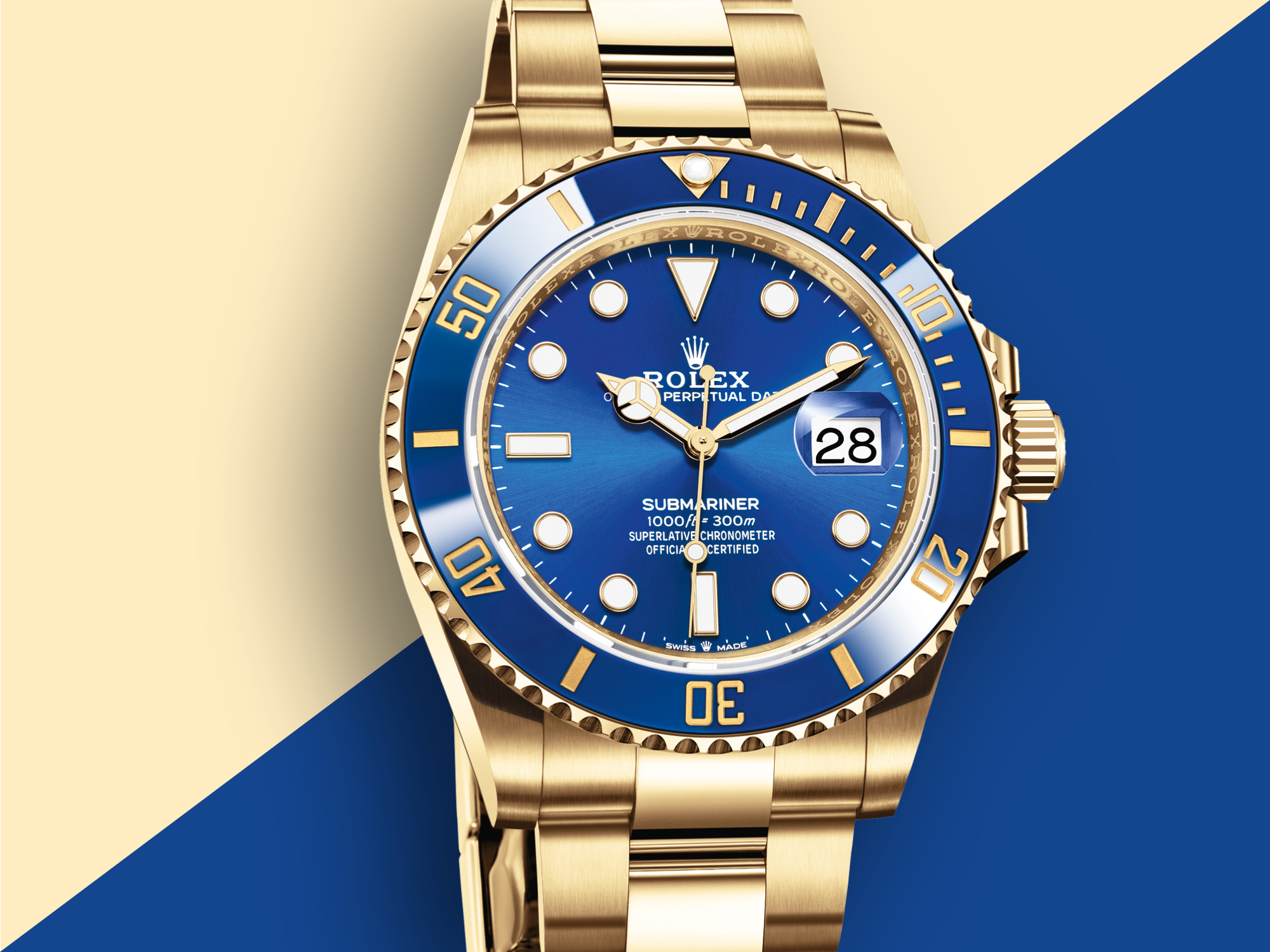
Submariner
Jonathan says: ‘The Submariner was the first Rolex that ever caught my attention – my friend’s dad had a stunning yellow gold one with a blue dial. It made me hope that one day I would be lucky enough to own one. For me it is an icon of style, as well as a beautifully functional watch. Many clients clearly agree because we always get asked about the Submariner.’
When the Submariner was launched in 1953, it was the first diving watch to be waterproof to 100 metres. The key for Rolex is maintaining a classic watch that people love but updating it to make sure that it stays at the forefront of watch technology. In the latest Submariner this means an insert in the 60-minute unidirectional rotating bezel made from a corrosion-resistant, virtually scratchproof Rolex-patented ceramic called Cerachrom. Last year the case size was enlarged slightly from 40mm to 41mm. The case is available in either Oystersteel, Oystersteel and gold, or solid gold, with matching Oyster bracelet. The bezel insert comes in either black, green or blue, and dials in either black or blue. Cases are either Oystersteel, yellow gold, or a mixture of steel and yellow gold. The bracelet is equipped with an Oysterlock clasp to prevent accidental opening, and Rolex’s Glidelock system, allowing for fine adjustments of up to 5mm for perfecting the fit on your wrist, or for slipping over a diving suit. The Submariner has Rolex’s new calibre 3230 movement, while the Submariner Date has the new 3235 movement. Both movements have the high-efficiency Chronenergy escapement with Rolex’s anti-magnetic Parachrom hairspring and Paraflex shock absorbers.
Submariner from £6,450
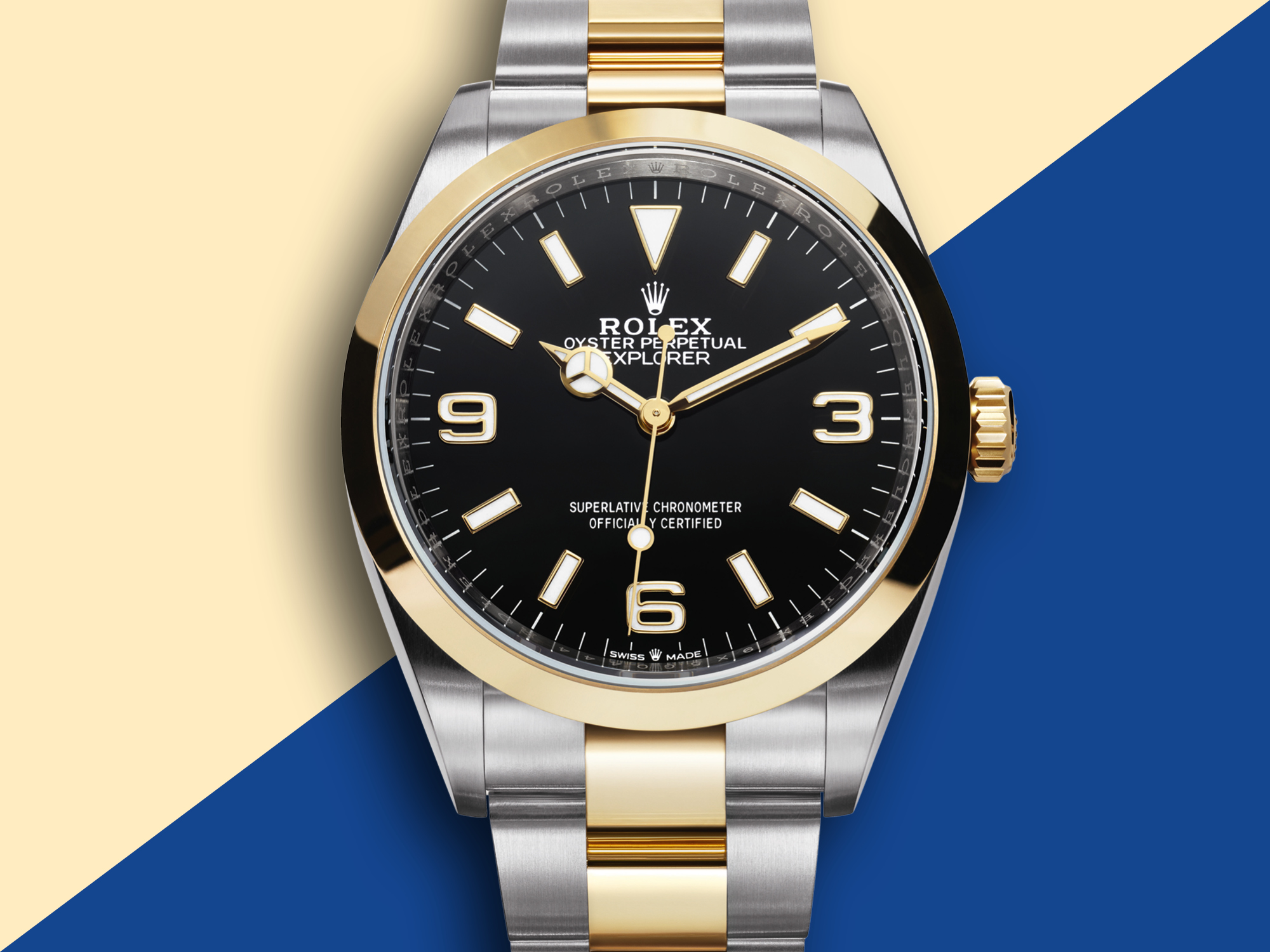
Explorer
Bale says: ‘With its 36mm case size, the next-generation Explorer wears more like a vintage piece. The Explorer has always appealed to people who like the combination of a very clean, legible watch that traces its origins back to a celebration of Sir Edmund Hillary and Tenzing Norgay’s first ascent of Everest. The smaller case broadens the appeal of this iconic mainstay of Rolex’s professional range.’
Rolex has unveiled a new generation of the Oyster Perpetual Explorer. At 36mm, the case returns to the size of the original model launched in 1953. The new Explorer is released in a yellow Rolesor version – the bezel, winding crown and centre links of the bracelet are in 18ct yellow gold, the case and outer links of the bracelet are in Oystersteel. The lacquered black dial contrasts with the large 3, 6 and 9 numerals that are part of the Explorer’s signature look. The new-generation Explorer is equipped with calibre 3230, a self-winding movement entirely developed and manufactured by Rolex. The movement offers a power reserve of approximately 70 hours, as well as outstanding reliability, and resistance to shocks and magnetic fields. The 36mm Oyster case is guaranteed waterproof to a depth of 100 metres. The middle case is crafted from a solid block of Oystersteel, a particularly corrosion-resistant alloy. The caseback is hermetically screwed down with a special tool that allows only Rolex watchmakers to access the movement. The crystal is made of virtually scratchproof sapphire, and there is an international five-year guarantee.
Explorer, £8,700

Explorer II
Jonathan says: ‘The new Explorer II is visually similar to before but the changes are actually quite significant, with a reconfigured case, updated Chromolight display for better visibility and a longer power reserve. For me it is one of the best professional watches out there, and one that flies under the radar compared to some other Rolex models.’
The new version of the Oyster Perpetual Explorer II comes with a redesigned case and bracelet. It also has an optimised Chromalight display – the hour markers and hands giving a blue glow that now lasts longer thanks to the innovative luminescent material. An orange 24-hour hand distinguishes clearly between day and night – useful underground, or in polar conditions – or allows for a second timezone when you are travelling. The Explorer II first came out in 1971, becoming an essential tool for explorers travelling in extreme conditions. The new-generation Explorer II is fitted with calibre 3285, a self-winding mechanical movement developed in-house by Rolex and giving a power reserve of approximately 70 hours. The 42mm Oyster case of the new-generation Explorer II is guaranteed waterproof to a depth of 100 metres. The middle case is crafted from a solid block of Oystersteel, a corrosion-resistant alloy. The crystal is made of virtually scratchproof sapphire and is fitted with a Cyclops lens at 3 o’clock. The new Explorer II is fitted with an Oyster bracelet. Like all Rolex watches, the Oyster Perpetual Explorer carries Rolex’s Superlative Chronometer certification.
Explorer II, £6,800
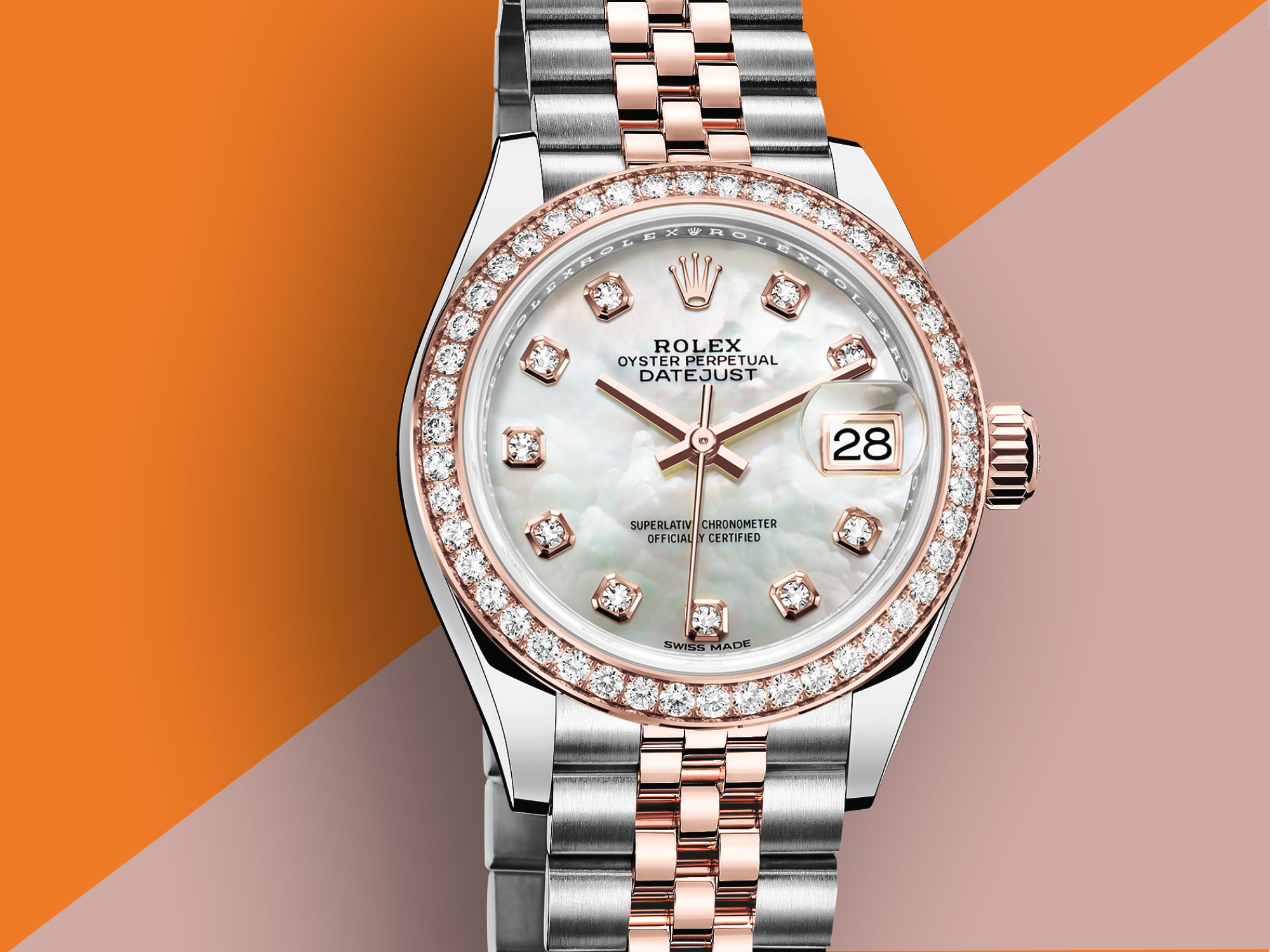
Lady-Datejust
Bale says: ‘The addition of the Lady-Datejust in the 1950s was a big moment. Although there were already ladies models, it was the first time Rolex brought out a range specifically designed for women. Clients still love the watch today, with all the functionality of a Datejust, but with a slim 28mm case in a whole range of styles – Oystersteel or gold, with a beautiful range of dial and gem-setting options too.’
Rolex was a pioneer of women’s wristwatches from the beginning. When men started wearing watches on their wrists at the beginning of the 20th century, the fear was that smaller case sizes wouldn’t be as robust as a big watch designed to be carried in your pocket. Rolex led the charge in disproving this theory, and women were front and centre, with the British swimming pioneer Mercedes Gleitze becoming an ambassador for the brand in the 1920s when she wore a Rolex Oyster that survived 10 hours being bashed around in the English Channel. So when the Lady-Datejust came out in 1957 it was far from the first women’s Rolex, but it was the first range aimed at women. It is available on a five-piece link Jubilee bracelet – designed for the launch of the Datejust in 1945, as well as the Oyster bracelet with Easylink comfort extension, or on the exclusive President bracelet in 18ct gold or 950 platinum with semi-circular, three-piece links. The movement is Rolex’s calibre 2236, a self-winding mechanical movement. Power reserve is approximately 55 hours. Like all Rolex watches, the Lady-Datejust carries the Superlative Chronometer certification.
Lady-Datejust from £5,250

